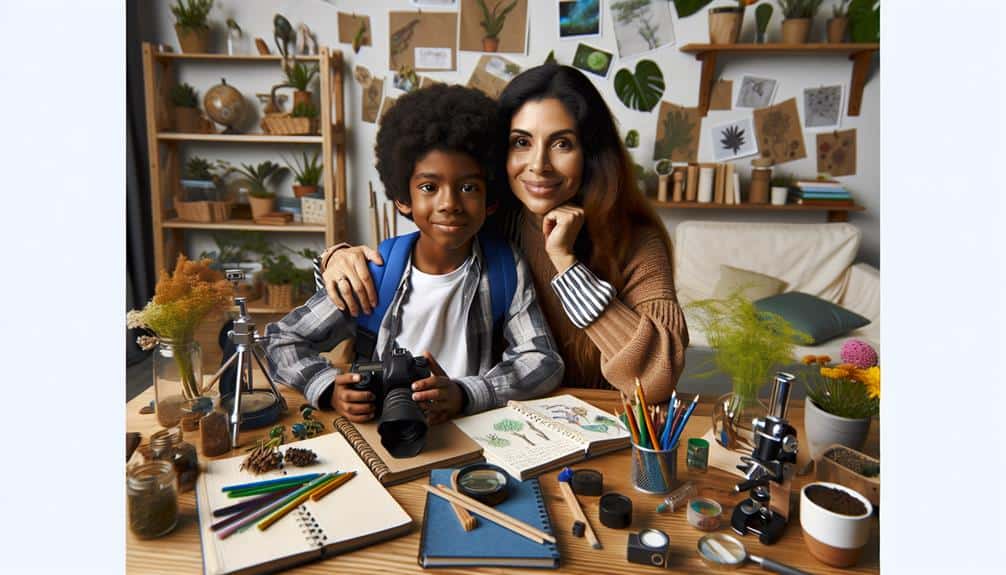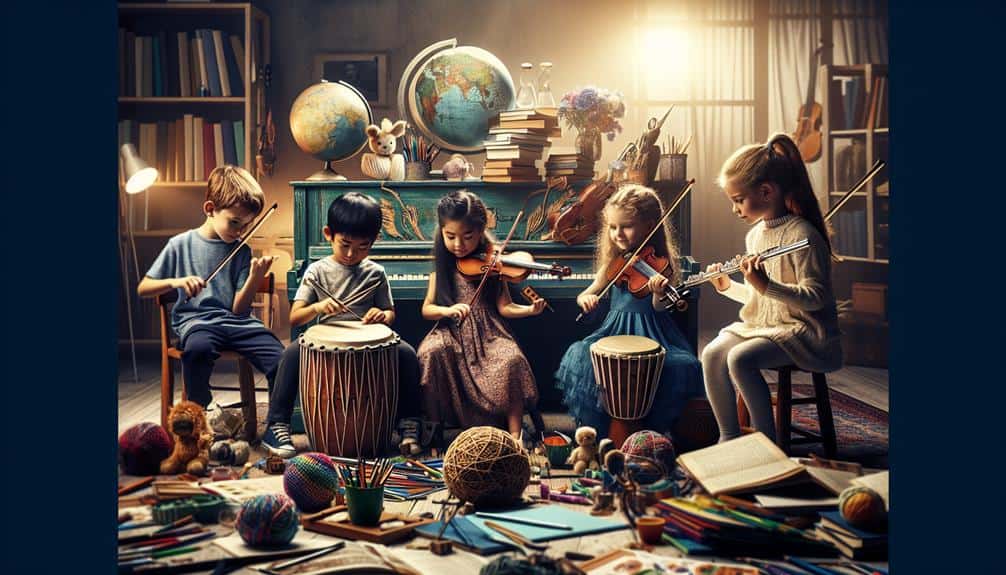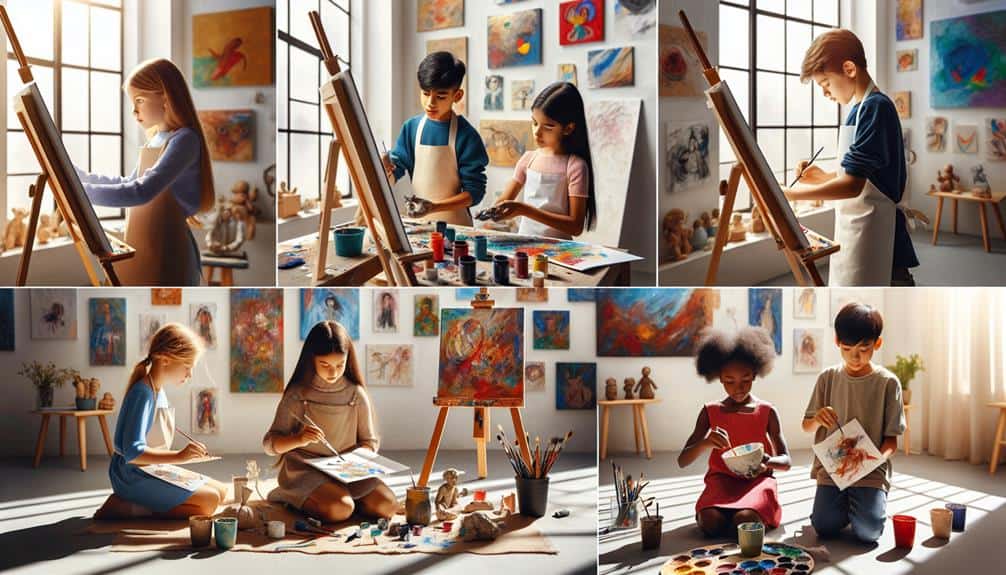In homeschooling, photography plays an essential role in nurturing creativity, honing observation skills, and enhancing storytelling abilities. Through photography, you can encourage artistic expression, develop critical thinking, and capture moments that evoke emotions. By utilizing photography as a tool, you can document experiments creatively, enhance scientific visualization, and promote mindfulness. The visual medium of photography not only cultivates a deeper understanding of the world but also fosters a sense of curiosity and exploration. Embracing photography in homeschooling opens up endless possibilities for engaging educational experiences.
Key Points
- Develop observation skills and creativity.
- Document educational experiences and adventures.
- Enhance storytelling and communication skills.
- Encourage artistic expression and visual literacy.
- Foster curiosity, critical thinking, and mindfulness.
Benefits of Integrating Photography
Integrating photography into homeschooling offers students a creative and engaging way to enhance their learning experience. Through photography, students can develop essential skills while exploring the world around them. One significant benefit is building confidence. As students capture images and experiment with different techniques, they gain a sense of accomplishment and pride in their work. This newfound confidence can extend beyond photography, positively impacting other areas of their academic and personal lives.
Moreover, photography plays an important role in cultivating curiosity. When students are behind the lens, they're encouraged to observe details, seek out new perspectives, and inquire about the subjects they're capturing. This curiosity fuels a natural desire for learning and exploration, helping students develop a deeper understanding of the world. By nurturing their inquisitive nature through photography, homeschooling students can become more engaged and proactive learners in various subjects.
Developing Creativity Through Photography
To foster creativity through photography, homeschoolers like you can engage in activities that encourage artistic expression. This includes experimenting with different angles and perspectives. Enhancing visual storytelling skills can be achieved by capturing images that convey emotions, narratives, and unique perspectives.
Encouraging Artistic Expression
Encourage your child's artistic expression by fostering creativity through the lens of photography. Photography can be a powerful tool for inspiring imagination and promoting mindfulness in homeschooling.
By engaging in photography, children have the opportunity to explore their creativity, experiment with different perspectives, and capture moments that resonate with them.
Through the act of taking photographs, children learn to observe the world around them more closely, paying attention to details they may have otherwise overlooked. This practice of mindfulness can help them appreciate the beauty in everyday life and develop a deeper connection with their surroundings.
Photography also encourages artistic expression by allowing children to convey their thoughts, emotions, and ideas visually. By experimenting with composition, lighting, and subject matter, children can express themselves in unique and creative ways. This process not only enhances their artistic skills but also boosts their confidence and self-expression.
Incorporating photography into homeschooling can provide a platform for children to explore their creativity, develop their artistic voice, and cultivate a deeper appreciation for the world around them.
Enhancing Visual Storytelling
Enhancing visual storytelling through photography involves capturing moments that evoke emotions and convey narratives effectively. Photo journaling can be a significant tool in homeschooling, allowing you to document daily activities, special events, and memorable experiences.
By engaging in creative projects that involve photography, such as creating visual stories or thematic photo series, you can enhance your storytelling skills and develop a deeper understanding of composition and visual communication.
Family albums play an important role in memory keeping and preserving the homeschooling journey. Through photography, you can create a visual timeline of your educational adventures, showcasing growth, achievements, and cherished moments.
Encouraging children to participate in building family albums not only enhances their creativity but also fosters a sense of ownership and pride in their work.
Fostering Observation Skills
Developing creativity through photography involves honing observation skills to capture unique perspectives and moments that tell compelling stories visually. By engaging in photography as part of homeschooling, you can actively foster critical thinking and attention to detail in your daily learning experiences.
Through the lens of a camera, you have the opportunity to explore the world around you with a heightened sense of awareness, encouraging you to pay attention to the intricate details that often go unnoticed.
Photography prompts you to think critically about composition, lighting, and subject matter, challenging you to analyze scenes from different angles and perspectives. This process not only enhances your observational skills but also encourages you to interpret and communicate your findings creatively.
Enhancing Observational Skills With Photography
Strengthen your ability to keenly observe details by practicing photography in your homeschooling curriculum. Engaging in nature exploration and outdoor adventures with a camera in hand can greatly enhance your observational skills. Here's how photography can aid in honing your ability to observe:
- Focus on Details: Through photography, you learn to pay attention to intricate details in your surroundings, whether it's the delicate veins on a leaf or the texture of a tree bark.
- Develop Visual Literacy: By framing shots and capturing scenes, you train your eye to see composition, lighting, and perspective, which are essential elements in observational skills.
- Encourage Patience: Waiting for the perfect moment to click a photograph teaches you patience and the value of observing a subject over time.
- Promote Mindfulness: Photography encourages you to be present in the moment, heightening your awareness of your surroundings and fostering a deeper connection with nature.
Using Photography for Storytelling
Photography serves as a powerful tool for capturing and conveying compelling narratives, allowing homeschoolers to explore the world of storytelling through visual imagery. By delving into creative compositions and narrative photography, students can craft engaging stories and convey emotions through their photos.
Visual storytelling becomes a dynamic way to express ideas, experiences, and perspectives, making learning more immersive and interactive.
Encouraging homeschoolers to create photo essays can enhance their storytelling skills by structuring a sequence of images to narrate a cohesive story. This process not only fosters creativity but also hones their ability to communicate effectively through visuals.
Through visual storytelling, students can learn to observe details, understand sequencing, and evoke emotions in their audience.
Engaging in narrative photography allows homeschoolers to explore diverse themes, perspectives, and concepts, fostering critical thinking and creativity. By incorporating photography into their storytelling endeavors, students can develop a deeper appreciation for the art of visual communication.
Incorporating Photography in Science Lessons
You can enhance your science lessons by incorporating photography to visualize complex scientific concepts and make them more accessible and engaging for your homeschooling students.
Encourage your students to document their experiments creatively through photography, allowing them to capture the process and results in a unique and visually appealing way.
Visualizing Scientific Concepts
By capturing images that visually represent scientific concepts, you can deepen your understanding and engagement in science lessons through the incorporation of photography in homeschooling. Here's how photography can help you visualize scientific concepts:
- Capturing Experiments: Use photography to document each step of your experiments, providing a visual record that can aid in understanding the scientific process.
- Visualizing Theories: Create visual representations of complex scientific theories through photography, making them more accessible and easier to comprehend.
- Creative Exploration: Encourage creativity by allowing you to experiment with different angles, lighting, and compositions to visually represent scientific concepts in unique ways.
- Scientific Visualization: Enhance your ability to visualize abstract scientific ideas by translating them into concrete images through photography.
Documenting Experiments Creatively
To creatively document experiments in science lessons, consider integrating photography as a dynamic tool for capturing and showcasing the process and results visually. Creative documentation through photography allows for an artistic exploration of scientific experiments, transforming the mundane into visually engaging narratives. By incorporating photography into your homeschooling curriculum, you can encourage a deeper understanding of scientific concepts while fostering creativity and visual literacy in your child.
When documenting experiments, encourage your child to experiment with different angles, lighting, and compositions to capture the essence of each step. Encourage them to think creatively about how to visually represent the hypothesis, methods, observations, and conclusions of their experiments. This not only enhances their scientific understanding but also cultivates their artistic skills.
Through artistic exploration in documenting experiments, photography can become a powerful tool for your child to express their scientific discoveries in a visually compelling way. Embracing photography in science lessons not only adds a creative element but also reinforces the importance of observation and attention to detail in scientific inquiry.
Photography as a Tool for Self-Expression
How can photography serve as a powerful medium for homeschoolers to express themselves creatively and emotionally?
Photography goes beyond capturing images; it allows homeschoolers to explore self-discovery and emotional exploration through visual storytelling. Here are some ways photography can be a tool for self-expression:
- Emotional Outlet: Photography provides a safe space for homeschoolers to channel their emotions and thoughts into visual representations, helping them make sense of their feelings.
- Creative Freedom: Through photography, homeschoolers can experiment with different styles, techniques, and subjects, allowing them to express their unique perspectives and creativity.
- Self-Reflection: Looking through the lens enables homeschoolers to reflect on their experiences, beliefs, and values, fostering deeper self-awareness and personal growth.
- Communication: Photography offers homeschoolers a non-verbal way to communicate their ideas, stories, and identity to others, bridging gaps and fostering understanding.
Frequently Asked Questions
How Can Photography Be Used for Teaching History in Homeschooling?
When teaching history in homeschooling, you can enhance learning through photography. Encourage history reenactments to bring the past to life or create timeline collages using photos to visualize historical events, fostering a deeper understanding.
What Are Some Ways to Incorporate Photography in Math Lessons?
To enhance math lessons with photography, you can visually represent graphing shapes and measurement comparisons. Encourage your students to capture real-world examples of shapes and sizes, fostering a deeper understanding of mathematical concepts through hands-on exploration.
Can Photography Help Children Learn About Different Cultures?
Exploring different cultures through photography can boost cultural appreciation. Visual storytelling is a powerful tool to connect with diverse traditions. Did you know that 80% of students find learning about other cultures through images enhances their understanding?
How Can Photography Be Used for Enhancing Language Arts Skills?
To enhance language arts skills, you can tap into photography's power for creative writing and visual storytelling. By interpreting images, crafting narratives, and exploring emotions evoked by photographs, you'll deepen your language proficiency and storytelling abilities.
Are There Specific Photography Projects for Teaching Geography?
Explore the world through your lens. Capture cultural landscapes to teach geography. Develop mapping skills by photographing different regions. Immerse yourself in diverse environments, blending art and education seamlessly.



